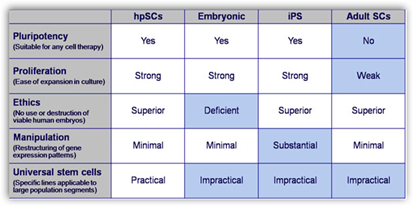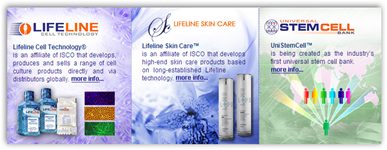This is an interesting company as they are involved in research and development of stem cells relating to diabetes, liver disease and more and have several patents in  this area both internationally and in the US. Now what is also interesting here is the launch of “stem cell” cosmetics as another part of their business model, with retail sales on the web. Recently I posted about “spray on” stem cell use that is about ready for clinical trials, so I guess to assume, the cosmetic end of the business is ready to advance as well. If you read further down there’s a bit of an explanation of the 4 types of stem cell technologies.
this area both internationally and in the US. Now what is also interesting here is the launch of “stem cell” cosmetics as another part of their business model, with retail sales on the web. Recently I posted about “spray on” stem cell use that is about ready for clinical trials, so I guess to assume, the cosmetic end of the business is ready to advance as well. If you read further down there’s a bit of an explanation of the 4 types of stem cell technologies.
Spray On Stem Cells for Treating Burns and Open Wounds–Regenerative Medicine
From the website:
International Stem Cell Corporation (OTCBB:ISCO) develops a powerful new stem cell technology called “parthenogenesis” that promises to significantly advance the field of regenerative medicine by addressing the significant problem of immune-rejection. Parthenogenesis utilizes unfertilized human eggs to create “parthenogenetic” stem cells (hpSC) that can be “immune-matched” to millions of persons of differing sexes and racial backgrounds. A relatively small number of hpSC lines could provide sufficient immune-matched cells to cover large parts of the world’s population. ISCO plans to create a bank of these valuable hpSC lines (UniStemCell™) to serve all populations across the world.
Human parthenogenetic stem cells have great therapeutic potential, yet do not require viable human embryos, thus avoiding ethical issues. ISCO’s scientists are focused on using hpSC to treat severe diseases of the eye, the nervous system and the liver where cell therapy has been proven clinically yet is limited by the availability of safe immune-matched human cells.
ISCO advances and operates three businesses.
“To derive and characterize the therapeutic cells derived from parthenogenetic stem cells we collaborate with the leading Universities and Companies:
- Novocell Inc, San Diego, California, endocrine pancreas cells;
- University of California, San Francisco, California, hepatocyte cells;
- University of California, Irvine, California, retinal pigment epithelium;
- University of Wurzburg, Germany, neuronal cells;
- The Scripps Research Institute, La Jolla, California, characterization of human parthenogenetic stem cells.
- The Acacio Fertility Center.
- California Center for Reproductive Medicine”.
From the website:
”UniStemCell bank is the life science industry’s first collection of non-embryonic histocompatible human stem cells available for research and commercial use. International Stem Cell Corporation (OTCBB:ISCO) has developed a proprietary technique for creating histocompatible stem cells. The process called parthenogenesis uses unfertilized human eggs and results in the cells inheriting a duplicate set of human leukocyte antigen (HLA) genes. This significantly reduces the possibility of the derived cells being rejected by an individual’s immune system making a single cell line suitable for treating millions of individuals. A relatively small number of such cell lines could be sufficient to provide “immune matched” cells to a large percentage of the world’s population.Parthenogenesis utilizes unfertilized human eggs to create “parthenogenetic” stem cells (hpSC) that are potentially histocompatible with millions of individuals of differing sexes and racial backgrounds. This means a relatively small number of hpSC lines could provide sufficient immune-matched cells to cover large parts of the world’s population.
Unlike human embryonic stem cells (hESC), hpSC do not require viable human embryos, thus avoiding most ethical concerns.
Unlike induced pluripotent stem cells (iPS), hpSC do not require the transfection of genes into somatic cells with the associated possibility of introducing unwanted additional genes.”
The chart below explains in brief the 4 types of stem cell processes.
 In following some of the recent developments with stem cells there’s a big move starting to continue and further advance stem cell storage areas around the world.
In following some of the recent developments with stem cells there’s a big move starting to continue and further advance stem cell storage areas around the world.
Cord Blood America To Buy Mexican Stem Cell Storage Company
The new stem cell area of their business of course relates to avoiding the aging  processes, which we all open ears when hearing news in this area. The cosmetic end of the business has their own website as well which explains their stem cell technology serums and processes.
processes, which we all open ears when hearing news in this area. The cosmetic end of the business has their own website as well which explains their stem cell technology serums and processes.
The products state they use patented non-embryonic stem cell extract to help rejuvenate your skin. The products are not cheap and be ready to shell out a few hundred dollars to order. This is interesting as it is the first I have seen with cosmetic retail sales with stem cells and again based on their educational and research programs they have patented technologies included in the products. If nothing else this post will give you a real quick summary about the different types of stem cell technologies that exist out there today. BD
The use of stem cells has often been a controversial issue in the media. International Stem Cell Corp. looks set to tackle the issue head on after launching its own line of stem cell based beauty products. According to reports online the skin care range was created by its wholly owned subsidiary Lifeline Skin Care.




0 comments :
Post a Comment